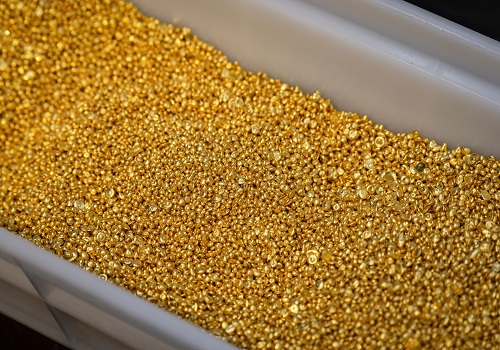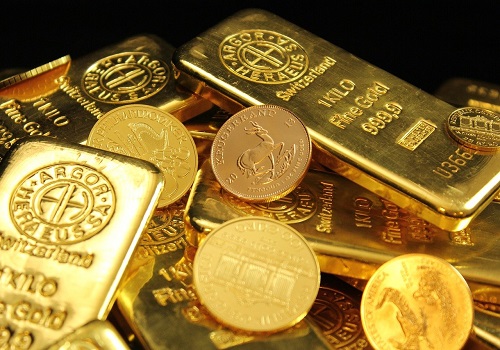Cottoncandy trading range for the day is 55700-56260 - Kedia Advisory

Gold
Gold prices settled higher by 0.85% at 79,233, primarily driven by a weaker U.S. dollar and mounting U.S. election uncertainties. Safe-haven demand continues to support gold amid escalating geopolitical tensions, particularly the Middle East conflict and Ukraine-Russia war, intensified by reports of North Korea sending troops to Russia. The U.S. trade deficit surged to $108.2 billion in September 2024 from $94.2 billion, marking the widest gap since March 2022, while wholesale inventories dropped by 0.1% month-over-month, indicating a weaker economic outlook. Inventory levels of durable goods also fell by 0.2%, while non-durables rose by 0.2%. In India, gold dealers have begun offering up to $8 an ounce discount over official domestic prices, as record high prices impact demand during the festive season. China’s discounts also narrowed as gold demand remains low due to high prices and economic slowdown, though September imports rose sharply to 16.151 metric tons, more than doubling from August. Nonetheless, China's total consumption from January to September dropped 11.18% year-on-year to 741.732 metric tons, with gold jewelry demand declining by 27.53% amid reduced consumer interest. Domestically mined gold output also saw a slight 1.17% dip in the same period. Technically, the gold market remains in fresh buying territory, with open interest up by 2.52% to 14,555 contracts, a sign of increasing interest in the asset. Immediate support is set at 78,820, with a potential decline toward 78,400 if this level is breached. Resistance is positioned at 79,470, and a breakthrough could push prices to test 79,700 levels.
Trading Ideas:
* Gold trading range for the day is 78400-79700.
* Gold rose aided by a softer U.S. dollar and U.S. election jitters.
* The US trade deficit widened sharply to $108.2 billion in September of 2024 from the $94.2 billion gap in the earlier month.
* US wholesale inventories fell by 0.1% month-over-month to $905 billion in September 2024
Silver
Silver prices surged by 1.34% yesterday, reaching 98,730, as safe-haven demand remained robust amid global uncertainties around the U.S. presidential election and escalating Middle East tensions. Recent U.S. economic data indicated a slowdown in labor market momentum, with job openings falling by 418,000 to 7.443 million in September, below market expectations. The quits rate, a key indicator of voluntary job exits, dropped to 1.9%, reflecting cautious sentiment among U.S. workers as economic conditions shift. Meanwhile, geopolitical risks intensified as Israeli strikes in Lebanon resulted in significant casualties, adding to the broader risk-off sentiment. In the commodities market, the U.S. dollar and Treasury yields paused their rally as investors awaited upcoming U.S. economic data, providing temporary support for silver prices. Anticipation is also building around the National People's Congress meeting on November 4-8, where potential stimulus announcements from Beijing could influence market sentiment further. India’s silver imports are poised to nearly double this year, driven by increased demand from the solar panel and electronics sectors and investors’ belief in silver’s potential outperformance compared to gold. India, the world’s largest silver consumer, imported 4,554 metric tons in the first half of 2024, a significant jump from 560 tons a year ago. Depleted inventories from last year have led industrial buyers to stockpile the metal to hedge against potential price hikes. Technically, silver remains under fresh buying interest, with open interest up by 5.41% to settle at 24,046 as prices gained 1,306 rupees. Support is established at 97,560, with potential testing of 96,385 below this level. Resistance is expected around 99,620, and a break above could see prices testing the 100,505 level, suggesting a bullish trend if support holds.
Trading Ideas:
* Silver trading range for the day is 96385-100505.
* Silver rose as uncertainty surrounding the US presidential election and Middle East tensions continued to drive safe-haven demand.
* The number of job openings fell by 418,000 to 7.443 million in September 2024
* The number of job quits in the US fell to 3.071 million in September of 2024, the lowest since August 2020
Crudeoil
Crude oil prices declined by 0.74% to 5,668 as supply disruption concerns eased after Israel targeted only military and industrial locations over the weekend, avoiding Iranian oil facilities. Additionally, Israeli Prime Minister Netanyahu’s openness to a brief truce in Gaza further lowered geopolitical risk premiums. The focus has since shifted back to weak fundamentals, especially subdued demand growth from China and anticipated OPEC output increases. On the supply side, the U.S. Department of Energy is purchasing up to 3 million barrels for the Strategic Petroleum Reserve (SPR), adding to the 55 million barrels bought this year at an average price of $76 per barrel, significantly below the $95 per barrel selling price in 2022. Meanwhile, U.S. crude inventories saw an increase of 5.474 million barrels for the week ending October 18, surpassing market expectations, while distillate stocks dropped by 1.14 million barrels, against a predicted 2-million-barrel decline. Notably, stocks at the Cushing, Oklahoma hub fell by 0.346 million barrels. The EIA’s latest report forecasts that global oil demand growth will slow to 1.2 million bpd in 2025, reaching 104.3 million bpd, 300,000 bpd below prior estimates due to weakening economic activities in China and North America. U.S. demand is projected to reach 20.5 million bpd next year, while U.S. production is expected to hit 13.22 million bpd this year, slightly below earlier forecasts. Technically, crude oil is under fresh selling pressure as open interest increased by 1.41% to 15,417 contracts, signaling a stronger bearish outlook. Immediate support is at 5,607, with a possible dip to 5,545 if this level is breached. Resistance is likely at 5,752, and a move above could push prices to test 5,835.
Trading Ideas:
* Crudeoil trading range for the day is 5545-5835.
* Crude oil dropped as concerns about supply disruptions faded after Israel avoided hitting Iranian oil facilities.
* Prices weighed down by concerns about the outlook for demand from China, an increase in crude inventories in U.S.
* US seeks up to 3 million barrels of oil for emergency reserve
Naturalgas
Natural gas prices rose by 0.79% to 241.5, buoyed by a dip in production and expectations of slightly cooler weather, which could increase heating demand in the upcoming week. Despite mild weather overall, which has reduced demand, utilities have been injecting more gas into storage than usual, marking the second consecutive week of above-average injections. According to LSEG, gas output in the Lower 48 U.S. states fell slightly to 101.7 billion cubic feet per day (bcfd) in October, down from September’s 101.8 bcfd and the December 2023 record of 105.5 bcfd. Daily production recently dropped to a four-day low of 102.2 bcfd following an increase to 103.2 bcfd earlier in the week. Forecasts suggest warmer-than-normal weather will persist in early November, albeit cooler than late October conditions. As a result, LSEG expects gas demand, including exports, to increase from 99.3 bcfd this week to 102.1 bcfd next week. According to the U.S. Energy Information Administration (EIA), natural gas production in 2024 is expected to slightly decrease to 103.5 bcfd, with domestic consumption projected to rise to a record 90.1 bcfd before dipping back to 89.1 bcfd in 2025. The EIA also forecasts LNG exports to reach 12.1 bcfd in 2024, up from the 2023 record of 11.9 bcfd. Last week, U.S. utilities added 80 billion cubic feet of gas to storage, surpassing expectations of 61 bcf, bringing total storage to 3.785 trillion cubic feet—2.9% above the previous year’s level and 4.6% above the five-year average. Technically, natural gas is under short covering, with open interest down by 8.17% to 19,877. Support is currently at 236.9, with additional support at 232.2, while resistance is set at 244.8, and a breakthrough could see levels of 248.
Trading Ideas:
* Naturalgas trading range for the day is 232.2-248.
* Natural gas gains amid drop in output and forecasts for slightly cooler weather and a little more heating demand.
* With mild weather squeezing demand and output mostly rising, projected utilities likely injected more gas into storage than normal last week.
* Average gas output in the Lower 48 U.S. states slipped to 101.7 bcfd so far in October, down from 101.8 bcfd in September.
Copper
Copper prices rose by 0.85% to 845.2, buoyed by reports that China, the top metals consumer, may approve a substantial fiscal stimulus package to bolster its economy. Speculation is mounting around a potential 10 trillion yuan ($1.4 trillion) extra debt issuance, with 6 trillion yuan targeted at mitigating local government debt risks and 4 trillion for land and property purchases. This ambitious package, expected to be reviewed by China’s top legislative body from Nov. 4-8, has renewed optimism about increased demand for industrial metals. Demand for copper has been under pressure from slowing global economic growth, particularly in China, although some sectors like solar and wind energy remain robust. China's refined copper production in September rose slightly by 0.4% year-on-year to 1.14 million metric tons, with daily average output calculated at 38,000 tons. The global refined copper market displayed a surplus of 54,000 metric tons in August, down from 73,000 tons in July, indicating some improvement in market balance. For the year’s first eight months, however, the market held a significant 535,000 metric ton surplus, reflecting broader demand-supply imbalances. China’s imports of unwrought copper grew to 479,000 tons in September, a 15.4% increase from August, driven by improving seasonal demand. Year-to-date copper imports have risen by 2.6%, while copper concentrate imports are up by 3.7% from the prior year, totaling 21.06 million tons through September. Technically, copper is witnessing short-covering, with open interest down by 5.75% to 7,264 contracts, suggesting some liquidation of positions. Immediate support is seen at 836.5, with a potential decline to 827.9 if breached. Resistance is anticipated at 851.2, and a move above this level could push prices towards 857.3.
Trading Ideas:
* Copper trading range for the day is 827.9-857.3.
* Copper gains on revived hope for large fiscal stimulus in China
* China's top legislative body considering approving fresh fiscal package which could be worth over 10 trillion yuan on Nov 8
* China plans to approve raising of fresh 10 trillion yuan debt via special treasury, local government bonds in next few years.
Zinc
Zinc prices fell by 0.34% to 288.95 as rising stocks in LME warehouses for the third consecutive day eased supply concerns. This increase in stockpiles is driving a reduced cash premium over three-month zinc contracts, which narrowed to $18 a ton from last week’s $58 peak, indicating softer demand. Adding to market pressures, Chinese economic data pointed to sluggish demand, with September’s industrial profits marking the steepest decline of the year, further disappointing market expectations despite stimulus measures from the country. Production forecasts for global mined zinc in 2025 face uncertainty as Russia’s Ozernoye, expected to reach full-capacity output of 320,000 metric tons (2.5% of global supply) by 2025, encounters production challenges tied to equipment procurement sanctions. Meanwhile, the global zinc market deficit rose to 66,300 metric tons in August from 51,000 tons in July, with a surplus of 127,000 tons recorded in the first eight months of 2024, compared to 418,000 tons in the same period last year. China’s refined zinc production in September rose by over 2% month-over-month but fell by 8% year-over-year, exceeding forecasts. Production gains were driven by post-maintenance boosts from smelters in Sichuan, Gansu, Guangdong, Shaanxi, and Inner Mongolia. A continued increase in domestic refined zinc output is anticipated in October, led by production upticks in Inner Mongolia, Shaanxi, and Hunan, though some reduction is expected in Gansu due to maintenance. Technically, zinc remains under long liquidation as open interest dropped by 2.42% to 2,577. Support is at 285.9, with further support at 282.8, while resistance is likely at 292.9. A break above this could lead prices to test 296.8, though the trend remains pressured amid easing supply constraints.
Trading Ideas:
* Zinc trading range for the day is 282.8-296.8.
* Zinc prices retreated after stocks in LME registered rose for a third consecutive day
* Chinese data suggesting poor demand prospects added to disappointment with economic stimulus measures
* China’s industrial profits plunged in September, registering the steepest monthly decline of the year, owing to factors including weak demand
Aluminium
Aluminium prices edged down by 0.23% to 242.1, as stronger U.S. economic data tempered hopes for imminent Federal Reserve rate cuts. However, the downside was limited as alumina shortages spurred systematic buying by funds. The suspension of alumina exports by Guinea Alumina Corporation, a significant supplier, has tightened the alumina market, potentially impacting aluminium production. Data from the London Metal Exchange (LME) reveals a notable futures positioning, with one large holder accumulating more than 40% of open interest to buy aluminium for December and another holding 30-39% to sell in January, which may add volatility to near-term prices. On the demand side, Goldman Sachs raised its 2025 aluminium price forecast from $2,540 to $2,700 per ton, citing expected demand growth in China spurred by fiscal stimulus. Meanwhile, the IMF lowered its 2025 global growth forecast to 3.2% due to ongoing geopolitical and economic risks, although it acknowledged central banks' efforts in managing inflation without triggering a recession. In terms of production, global primary aluminium output rose 1.3% year-on-year to 6.007 million tons in September, with China’s September aluminium output reaching 3.65 million tons, up 1.2% from a year earlier, supported by stable hydropower in Yunnan. Chinese producers have benefited from firm demand and higher margins, with estimated industry profits averaging 2,379 yuan per ton, up 12.2% month-on-month. Technically, the aluminium market faces fresh selling pressure as open interest grew by 1.54% to 3,557 contracts, indicating increased bearish activity. Aluminium finds support at 240.6, with potential to dip to 239 if breached. Resistance is expected at 244.2, and surpassing this level could drive prices toward 246.2.
Trading Ideas:
* Aluminium trading range for the day is 239-246.2.
* Aluminium slipped amid signs of resilience in the US economy tempered expectations for aggressive Fed interest rate cuts.
* LME data showed one large futures position at more than 40% of open interest to buy aluminium in December.
* Goldman Sachs raised its 2025 aluminum price forecasts citing higher demand potential in top consumer China following stimulus measures.
Cottoncandy
Cotton prices declined by 0.18% to 56,010 as yarn markets face weak demand and payment challenges. The USDA has lowered India’s cotton production forecast for the 2024-25 season to 30.72 million bales, with ending stocks reduced to 12.38 million bales due to crop damage from heavy rains and pest infestations. While India’s production is down, global cotton output is projected to increase, driven by higher production in China, Brazil, and Argentina, offsetting reductions in the U.S. and Spain. In India, cotton acreage for the current kharif season has fallen by approximately 9% year-on-year to 110.49 lakh hectares, with production expected to decrease by 7.4% to 30.2 million bales due to lower planting area and weather damage. This decline may curb exports, forcing India to boost imports, which are anticipated to rise to 2.5 million bales from 1.75 million last year, according to the Cotton Association of India (CAI). Reduced exports and steady domestic demand at 31.3 million bales may support global prices. The U.S. cotton balance sheet for 2024/25 also reflects lower production, mill use, and exports. The NASS lowered U.S. cotton production by over 300,000 bales to 14.2 million due to recent hurricane damage, with weaker global demand further reducing exports by 300,000 bales. Technically, the cotton market remains under fresh selling pressure, with a 4.23% increase in open interest to 148 contracts, indicating a bearish stance. Immediate support is seen at 55,860, with a potential dip to 55,700 if breached. Resistance is positioned at 56,140, and a break above could push prices towards 56,260.
Trading Ideas:
* Cottoncandy trading range for the day is 55700-56260.
* Cotton dropped as yarn markets face weak demand and payment constraints.
* India's cotton production in 2024/25 is likely to fall by 7.4% from a year ago to 30.2 million bales.
* Cotton production is projected to increase in China, Brazil, and Argentina, more than offsetting reductions in the US and Spain.
* In the global 2024/25 cotton balance sheet, beginning stocks, production and consumption are increased.
Turmeric
Turmeric prices rose by 0.53% to settle at 13,178, driven by concerns over crop damage from heavy rains that could result in more extensive losses than initially anticipated. However, price gains remain capped as demand remains subdued and arrivals increase. The expected acreage for the new season is projected to be 30-35% higher than last year, suggesting a rise in production. Recent weather, characterized by a mix of dry spells and light rains, has been favorable for crop growth. In Vidarbha and Telangana, rains of 20 mm and 18 mm, respectively, have supported crop conditions, though low supply combined with adverse weather could push prices up as the harvest season approaches. Internationally, dry conditions in Indonesia have accelerated turmeric harvesting, with peak levels currently being reported. Higher sowing in regions like Erode, Maharashtra, Telangana, and Andhra Pradesh, which are reporting increases of up to 35%, adds to production expectations. Last year, turmeric was sown in approximately 3 to 3.25 lakh hectares, a figure now estimated to rise to 3.75-4 lakh hectares, potentially resulting in a harvest of 70-75 lakh bags in 2025. Exports have declined by 6.46% during April-August 2024 compared to the previous year, reflecting lower overseas demand. Technically, the market shows signs of short covering with open interest falling by 1.51% to 11,770 as prices increased by 70 rupees. Support is currently seen at 13,060, with further downside potential to 12,944, while resistance is expected around 13,242, and a move above could see prices testing 13,308. The trend remains sensitive to weather developments and fluctuating demand dynamics.
Trading Ideas:
* Turmeric trading range for the day is 12944-13308.
* Turmeric gains amid reports of crop damage due to heavy rains
* However upside seen limited due to lower demand amid a rise in arrivals.
* Recent weather conditions, which include dry weather followed by light rains, are benefiting crop growth.
* In Nizamabad, a major spot market, the price ended at 13775 Rupees dropped by -0.97 percent.
Jeera
Jeera prices declined by 0.51% to 24,280 amid increased arrivals in Unjha, with daily inflows reaching 15,000 to 16,000 bags. Farmers still hold around 35% of this season’s stock, while the carryover stock at the start of the new season is estimated at approximately 20 lakh bags. Exports are likely to pick up post-Diwali, with an estimated 15,000 to 17,000 tons expected to be shipped in October, and further increases anticipated for November-December. However, sowing for the next season is predicted to be lower, with cumin cultivation in Rajasthan expected to decrease by 10-15%, potentially reducing production by about 10%. India remains a competitive supplier, with prices around $3,050 per tonne, nearly $200-$250 lower than Chinese cumin, which may draw international buyers, including from China. The recent Middle East tensions have also bolstered export demand from Gujarat, benefiting Indian cumin exporters as Syria, Iran, and Turkey, traditional cumin producers, face challenges. Data from the Federation of Indian Spice Stakeholders indicates robust export growth, with July-September exports up 128% year-on-year to 52,022 metric tons, reflecting heightened demand from Europe and other regions ahead of festive seasons. Technically, the market shows signs of fresh selling, with a 1.6% increase in open interest to 1,713 contracts, indicating bearish sentiment. Immediate support for jeera is at 24,070, with a potential dip to 23,840 if breached. Resistance is positioned at 24,560, and a breakout above could push prices toward 24,820.
Trading Ideas:
* Jeera trading range for the day is 23840-24820.
* Jeera dropped as arrival has increased and on an average, 15,000 to 16,000 bags of cumin are coming daily in Unjha.
* There is a possibility of 25 percent reduction in cumin sowing in Gujarat
* Carryover stock of 20 lakh bags of cumin is estimated in the new season
* In Unjha, a major spot market, the price ended at 24992.9 Rupees dropped by -0.31 percent.
Views express by all participants are for information & academic purpose only. Kindly read disclaimer before referring below views























